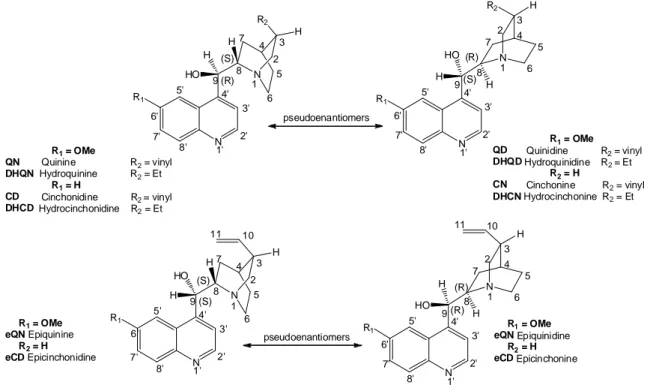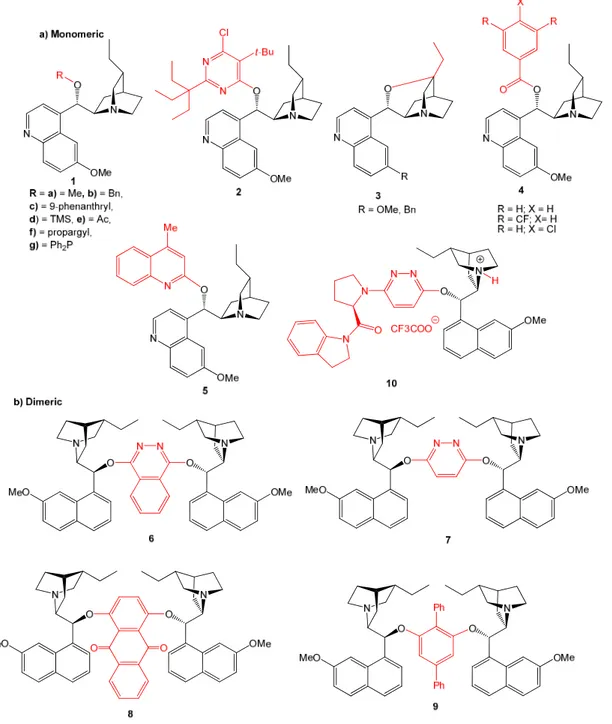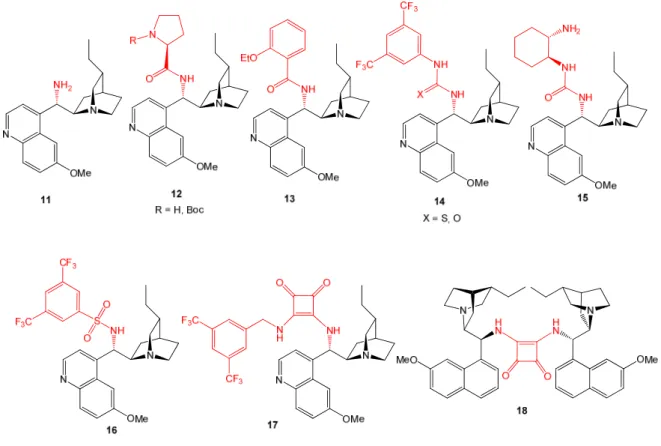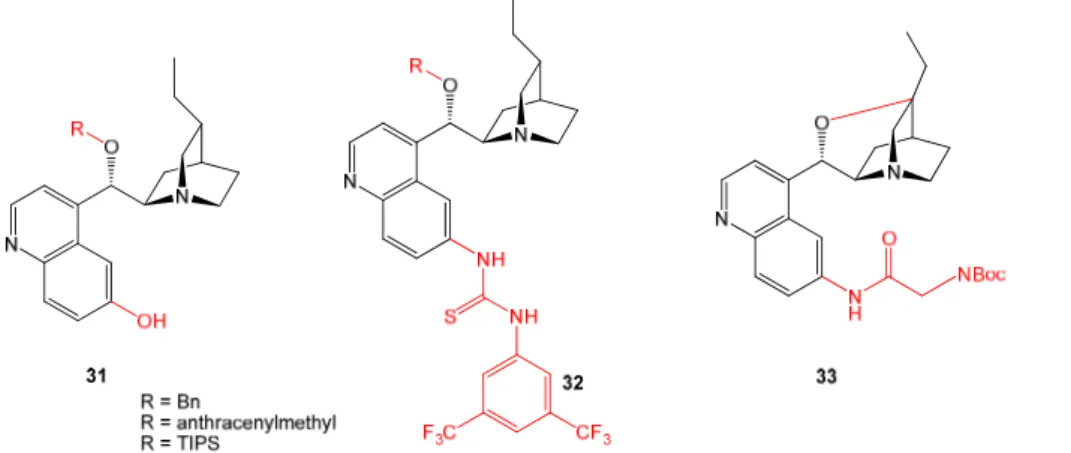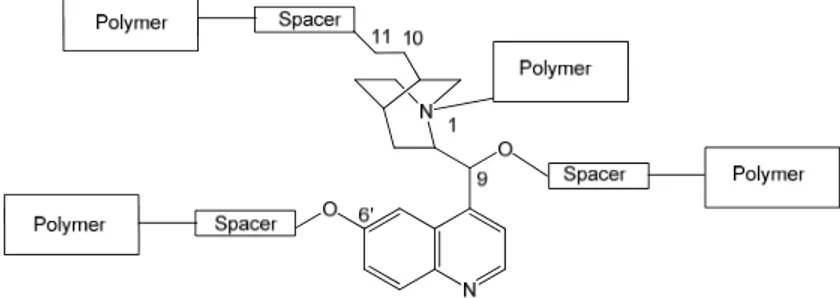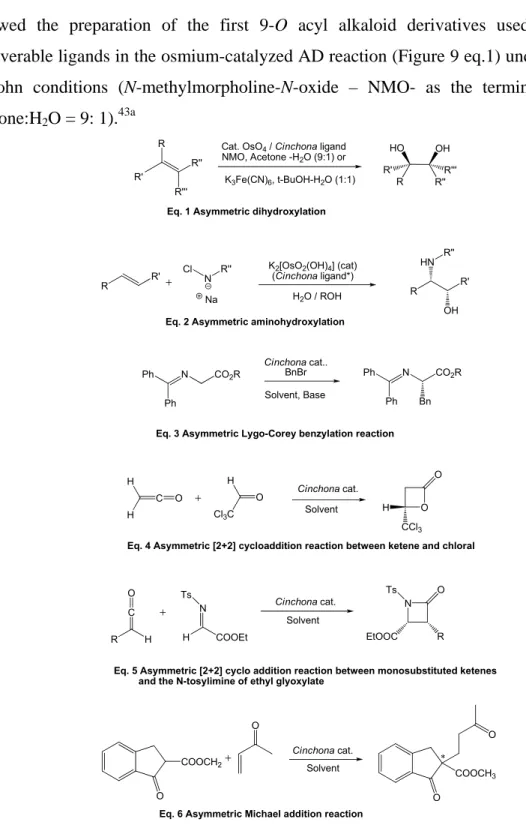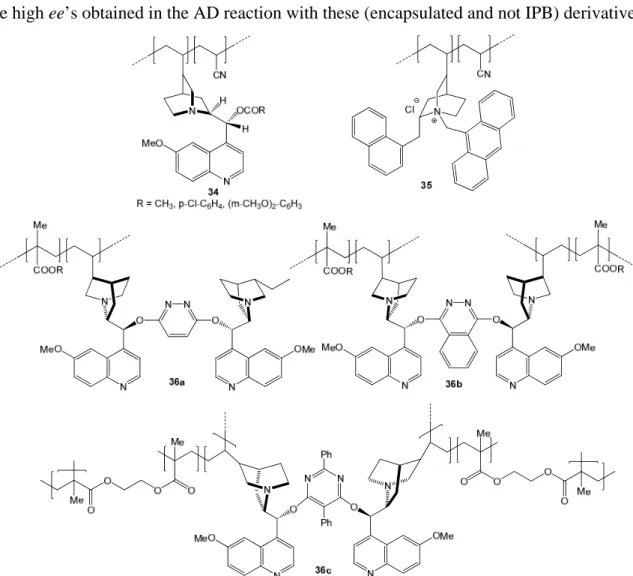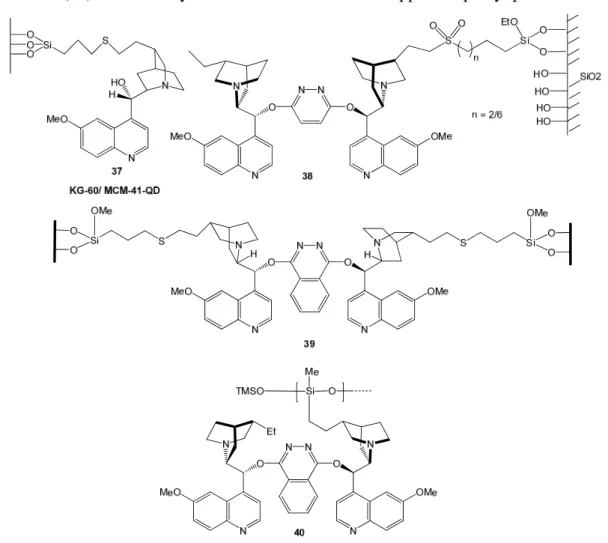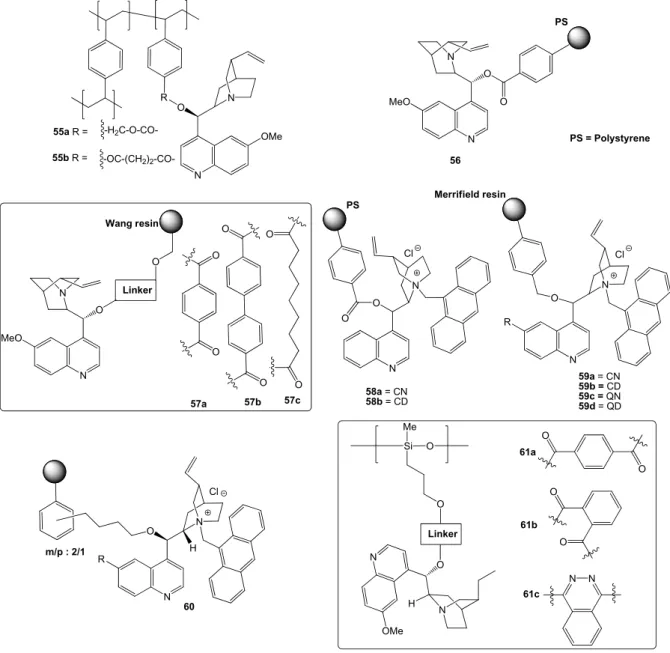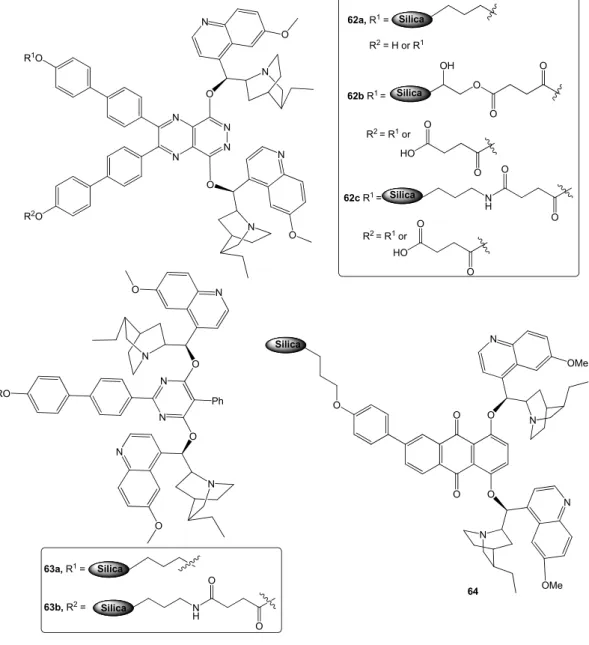UNIVERSITÀ DI PISA
DIPARTIMENTO DI CHIMICA E CHIMICA INDUSTRIALE
A Dissertation Submitted to the
GALILEO GALILEI Ph.D. SCHOOL XXIV CYCLE (2009-2011)
In Partial Fulfillment of the Requirements for the Degree of
DOCTOR OF PHILOSOPHY IN CHEMICAL SCIENCES
SUPPORTED LIGANDS AND ORGANOCATALYSTS FOR
ENANTIOSELECTIVE TRANSFORMATIONS: A
PRACTICAL FEASIBILITY PERSPECTIVE
By
Ravindra Panjabrao Jumde
Supervisors
Prof. Dario Pini
Dr. Alessandro Mandoli
External Supervisor
Dedicated to
My Sister (Kiran)
All truths are easy to understand once they are
discovered; the point is to discover them.
Acknowledgement
First and foremost, I offer my sincerest gratitude to my esteemed supervisors Professor Dario Pini and Dr. Alessandro Mandoli for their erudite and scrupulous supervision and long-lasting patience which gave me constant encouragement and guidance. Their painstaking efforts, immense insight, inspiring attitude, enthusiasm and in particular the provided friendly atmosphere in the lab made this task much easier and joyful than expected.
The thought provoking comments by Dr. Alessandro Mandoli and keen insight in identifying various facets of problems have been a source of enduring patience to me without which this work could neither gather substance nor assume the present form. His scholarship, humanity made my task a joy. His efficacy led to broadcasting and deepening of my understanding of the research problem. It is a great pleasure and privilege for me for being associated with both of my supervisors. I shall always remain beholden to them.
I would also like to show my gratitude to my external supervisor Prof. Maurizio Benaglia for his attentive corrections and comments in the Thesis.
The collaborative help from Prof. Gloria Uccello-Barretta and Dr. Federica Balzano for the NMR studies, Dr. Angela Cuzzola for mass- and Dr. Antonella Manariti for IR-measurements is gratefully acknowledged.
I sincerely thank Ms. Anila Di Pietro, Mr. Alessio Stefanini, Ms. Federica De Lorenzi and Mr. Damiano Cancogni, for their initial contribution in this Thesis work. I would also like to thank Prof. Anna Iuliano for her encouragement and cheerful presence in the lab.
I wish to express my acknowledgment to Galileo Galilei PhD School, University of Pisa for the financial support unless otherwise this Thesis would not have been possible.
I am also greatly indebted to my teachers in past: Dr. P. G. Rohankar and Ms. Deshmukh (Jagadamba Mahavidyalaya, Achalpur City, S.G.B. Amravati university, India), and Prof. V.G. Deshmukh and Prof. P. R. Mandlik (Master degree, Shri Shivaji Science College, Amravati, S.G.B. Amravati university, India) who have taught me the basic chemistry and inspired me to perceive my doctoral degree in chemistry.
I would like to especially thank my previous mentors Mr. S. S. Joshi, Dr. R. Jaganathan, (National Chemical Laboratory, Pune, India) who had developed my interest in
research by allowing me to carry out work of my interest (organic synthesis) and Dr. T. Raja for encouraging me to perceive doctoral degree abroad.
Special thanks to all my friends, Pappu and Mintu (friends from my childhood), Sushil M., Sunil, Krishna, Avinash, Suresh, Amol D. T., Amol D. Shailesh (college friends) Dr. Yogesh V., Dr. Pravin U., Mr. Rajendra, Dr. Nishant for supporting me through all the ups and downs and helping me whenever I needed it.
I do not have words to express my feelings towards my family: Mammy, Papa, Kiran (my sister) who have constantly encouraged and supported for my higher studies, and waiting long enough for my return, thank you very much. I would specially thank my sister who boosts my interest in Chemistry and insists me to take master degree in Chemistry.
Lastly and by no means least Varsha (my friend/wife/labmate), it is equally difficult to put into words my gratitude and love to you, we started on this journey almost together three years ago and throughout that time you became my morale booster. Thank you firstly for your friendship over the years; for your love, support, and encouragement and for being by my side through thick and thin.
ABBREVIATIONS... xiii
LIST OF FIGURES...xvii
LIST OF SCHEMES ... xxi
LIST OF TABLES ... xxiv
CHAPTER -1- INTRODUCTION ...1
General introduction ...3
1.1 Soluble systems ...5
1.2 Insoluble systems ...6
1.3 Cinchona Alkaloids in Chemistry: A brief overview ...13
1.4. IPB Cinchona alkaloid derivatives ...20
1.5. A critical evaluation of known IPB Cinchona derivatives and assessment of open questions. ...45
1.6. Aims, contents and plot of the Thesis...49
CHAPTER -2- DESIGN AND SYNTHESIS OF CLICKABLE CINCHONA ALKALOID DERIVATIVES ...51
2.1 Synthetic strategy ...53
2.2. Preparation of clickable pyridazine-core dimeric Cinchona alkaloid-derivatives...54
2.2.1 Preparation of 3,6-dichloro-1,2,4,5-tetrazine (96) ...56
2.2.2 Preparation of 3,6-dichloro-4-(hex-5-ynyl)pyridazine...59
2.2.3. Preparation of clickable ligands 100 a,b,c...59
2.3. Preparation of clickable triazine-core dimeric Cinchona alkaloid-derivative. ...62
2.3.1. Route-a: Preparation of 2,4-bis(10,11-dihydro-9-O-quinidinyl)-6-chloro-1,3,5-triazine (107). ...64
2.3.2. Route-b: Preparation of 2,4-dichloro-6-(prop-2-ynyloxy)-1,3,5-triazine (108a) and Preparation of 2,4-dichloro-6-(but-3-ynyloxy)-1,3,5-triazine (108b). ...65
2.4. Preparation of clickable anthraquinone-core dimeric Cinchona alkaloid-derivative. ...68
2.4.1. Preparation of (6-iodohex-1-ynyl)trimethylsilane (113c) ...69
2.4.3. Preparation of
6-bromo-1,4-bis(10,11-dihydro-9-O-quinidinyl)-anthracene-9,10-dione (110) ... 70
2.4.4. Preparation of 1,4-bis(10,11-dihydro-9-O-quinidinyl)-6-(4-(hex-5-ynyloxy) phenyl)anthracene-9,10-dione (114b) ... 71
2.5. Preparation of clickable propargyl alkaloid derivatives... 73
2.5.1. Preparation of propargyl QN/QD. ... 73
2.6 Conclusions ... 75
CHAPTER -3- PREPARATION OF POLYMER SUPPORTS ... 77
3.1 Introduction ... 79
3.2 Azidomethyl poly(styrene-co-divinylbenzene) resins (Merrifield and ArgoPoreTM type).79 3.2.1. Preparation of gel-type and macroporous azidomethylpolystyrene resins. ... 82
3.3 Azido-functionalized PS supports with oligo(ethylene oxide) cross-linkers. ... 83
3.3.1. Synthetic strategy ... 85
3.3.2. Synthesis of the monomers ... 86
3.3.3. Synthesis of cross-linked azidomethylpolystyrene supports ... 87
3.4. Porous monolithic polymer supports... 90
3.4.1. Attempts to prepare azidomethyl PS macroporous monoliths... 92
3.5. Preparation of Poly-HIPE materials ... 94
3.6 Conclusions ... 95
CHAPTER -4- IMMOBILIZATION OF ALKALOID DERIVATIVES ON TO POLYMER SUPPORTS AND PREPARATION OF MODEL COMPOUNDS... 97
4.1 Introduction ... 99
4.2. Immobilization of Cinchona alkaloid derivatives onto polymer supports ... 104
4.2.1 Preparation of pyridazine-core Cinchona alkaloid soluble model compounds 155a,b,c and 154... 105
4.2.2. Preparation of immobilized pyridazine-core Cinchona alkaloid derivatives 100a, 100b, 100c on azido-polystyrene resins 122x and 122y. ... 106
4.2.3. Preparation of immobilized Cinchona alkaloid derivatives on polymer beads 133v and 133z ... 107
4.3. Anthraquinone-core Cinchona alkaloid derivative 114b. ... 109
4.3.1. Preparation of the soluble 158b and the immobilized 158a anthraquinone-core Cinchona alkaloid derivative... 109
4.3.2. Preparation of immobilized Cinchona alkaloid derivative 158c...110
4.4. Propargyl alkaloid derivatives...111
4.4.1. Preparation of soluble model compounds 160a and 160b. ...111
4.4.2. Preparation of the immobilized Cinchona alkaloid propargyl derivatives 159a and 159b. ...112
4.5. Preparation of the soluble model compound of 1,3,5-triazine-core Cinchona alkaloid derivative...113
4.6. Attempt to immobilize the alkaloid derivative 100a onto the azido functionalized PolyHIPE material. ...114
4.7. Conclusions ...116
CHAPTER -5- ASYMMETRIC TRANSFORMATIONS USING POLYMER SUPPORTED CINCHONA ALKALOID ORGANOCATALYSTS ...117
5.1. Asymmetric dimerization of ketenes ...119
5.1.1. Asymmetric dimerization of ketene using soluble model catalysts ...122
5.1.2. Heterogeneous asymmetric dimerization of ketenes using IPB Cinchona alkaloid derivatives...124
5.2. Asymmetric alcoholysis of cyclic meso-anhydrides ...128
5.2.1. Asymmetric methanolysis of cis-1,2,3,6-tetrahydrophtalic anhydride using soluble model compounds ...130
5.2.2. Asymmetric methanolysis of cis-1,2,3,6-tetrahydrophtalic anhydride using the IPB organocatalyst 158c...132
5.3. Dynamic kinetic resolution of mandelic acid derivatives ...135
5.3.1 Screening of soluble models 155a and 160a in the DKR of rac-5-phenyl-1,3-dioxolane-2,4-dione. ...138
5.4. Asymmetric halolactonization reaction...141
5.4.1 Screening of the soluble model 155a in the asymmetric chlorolactonization of 4-(4-fluorophenyl)pent-4-enoic acid. ...143
5.5. Asymmetric α-amination of 2-oxindoles ...145
5.5.1. Asymmetric α-amination of 3-substituted-2-oxindoles. ...147
5.6. Recycling study of IPB-Cinchona alkaloid catalysts...156
5.6.1. Recycling in the dimerization of ketenes. ...157
5.6.3. Recycling in the asymmetric α-amination reaction ... 164
5.7 Conclusions ... 170
CHAPTER -6- CONCLUSIONS ... 173
Conclusions ... 175
Publications ... 181
CHAPTER -7- EXPERIMENTAL SECTION ... 183
7.1. General Methods and Materials ... 185
7.2. Experimental section for chapter-2 ... 186
7.2.1 Preparation of clickable pyridazine-core Cinchona alkaloid-derivatives (100a,b,c and 101). ... 186
7.2.2 Preparation of clickable triazine-core dimeric Cinchona alkaloid-derivatives (106a,b). ... 192
7.2.3 Preparation of the clickable anthraquinone-core dimeric Cinchona alkaloid-derivatives (114b). ... 197
7.2.4. Preparation of the clickable propargyl Cinchona alkaloid-derivatives (120a and 120b). ... 202
7.3. Experimental section for chapter-3 ... 203
7.3.1. Preparation of azidomethyl Merrifield (122x) and ArgoPoreTM (122y) resins ... 203
7.3.2 Synthesis of azidomethylstyrene and of oligo(ethylene oxide) polar monomers and cross-linker. ... 203
7.3.3 Preparation azido-functionalized polystyrene supports with oligo(ethylene oxide) cross linkers (133v and 133z). ... 205
7.4.4. Preparation of polymeric monolith (134) ... 207
7.4.5. Preparation of poly-HIPE... 208
7.4. Experimental section for chapter-4 ... 209
7.4.1 Preparation of pyridazine-core dimeric-Cinchona alkaloid soluble model compounds (155a,b,c). ... 209
7.4.2. Preparation of the pyridazine-core monomeric-Cinchona alkaloid soluble model compound (154). ... 211
7.4.3. Preparation of IPB pyridazine-core Cinchona alkaloid derivatives (156a/x, 156a/y, 156b/x, 156b/y, 156c/x, 157a/v, 157a/z, 157c/z)... 212
7.4.4. Preparation of the anthraquinone-core Cinchona alkaloid soluble model compound
(158b)...213
7.4.5. Preparation of IPB anthraquinone-core Cinchona alkaloid derivatives (158a, 158c).214 7.4.6. Preparation of propargyl Cinchona alkaloid soluble model derivatives (160a and 160b) ...215
7.4.7. Preparation of IPB propargyl Cinchona alkaloid derivatives (159a and 159b)...216
7.4.8. Preparation of the 1,3,5-triazine-core Cinchona alkaloid soluble model derivative (161)...217
7.5. Experimental section for chapter-5 ...218
7.5.1. Catalytic asymmetric dimerization of ketenes. ...218
7.5.2. Asymmetric methanolysis of cis-1,2,3,6-tetrahydrophthalic anhydride. ...220
7.5.3. General procedure for soluble model-Cinchona alkaloid-catalyzed dynamic kinetic resolution of 5-phenyl-1,3-dioxolane-2,4-dione. ...221
7.5.4. General procedure for soluble model-Cinchona alkaloid-catalyzed chlorolactonization of 4-(4-fluorophenyl)-pent-4-enoic acid...222
ABBREVIATIONS
AA Asymmetric aminohydroxylation AD Asymmetric dihydroxylation AIBN Azobisisobutyronitrile
AMST Azidomethyl styrene
aq. Aqueous
AQN Anthraquinone-1,4-diyl-
Ar Aryl group
BET Brunauer Emmett Teller surface area
BINAP 2,2'-Bis(diphenylphosphino)-1,1'-binaphthyl
Bn Benzyl group
Boc tert-Butyloxycarbonyl group
Cat. Catalyst
CBz Benzyloxy carbonyl group
CD Cinchonidine or 9-O-cinchonidinyl CN Cinchonine or 9-O-cinchoninyl CSP Chiral stationary phase
CuAAC Copper-catalyzed azide-alkyne cycloaddition DCDPH N,N’-dichlorodiphenylhydantoin
DCM Dichloromethane
DEAD Diethyl azodicarboxylate
DHQD 10,11-Dihydroquinidine or 9-O-10,11-Dihydroquinidinyl DHQN 10, 11-Dihydroquinine or 9-O-10,11-Dihydroquininyl DIAD Diisopropyl azodicarboxylate
DIPEA Diisopropylethylamine DKR Dynamic kinetic resolution DMF Dimethylformamide
DMSO Dimethyl Sulfoxide DVB Divinylbenzene eCD Epicinchonidine eCN Epicinchonine
EGDMA Ethylene glycol dimethacrylate
eQD Epiquinidine
eQN Epiquinine
Equiv. Equivalent
ESI-MS Electron spray ionization mass spectrometry
Et. Ethyl
FMOC Fluoren-9-ylmethoxycarbonyl
GC Gas chromatography
GLC Gas liquid chromatography
HEMA Hydroxyethylmethacrylate
HIPE High-internal phase emulsion
HPLC High-pressure liquid chromatography
IED-DA Inverse electron-demand Diels-Alder reaction
IL’s Ionic liquids
IPB Insoluble polymer bound
IR Infrared spectroscopy
IUPAC International Union of Pure and Applied Chemistry
KR Kinetic resolution
MCM-41 Mobil Catalytic Material Number 41
MMA Methyl methacrylate
MTBE Methyl tert-butyl ether
NMO N-Methylmorpholine-N-oxide
NMP N-Methylpyrrolidone; solvent
NMR Nucler magnetic resonance spectroscopy PEG Poly(ethylene glycol)
PHAL Phthalazine-1,4-diyl-
PMHS Poly(methylhydrosiloxane)
PS Polystyrene
PTC Phase transfer catalyst
PVA Poly(vinyl alcohol)
PYZ Pyridazine
QD Qunidine or 9-O-Qunidinyl
(QD)P Propargyl quinidine
(QD)P Propargyl quinine
Rf Retention factor
ROESY Rotating-frame Overhauser enhancement spectroscopy RTILs Room temperature ionic liquids
SPAN-80 Sorbitan monooleate emulsion stabilizer SPPS Solid-phase peptide synthesis
TBHP Tert-butylhydroperoxide TCCA Trichloroisocyanuric acid
TLC Thin layer chromatography
TMS Tetramethylsilane, also Trimethylsilyl
UV Ultra violet
LIST OF FIGURES
Figure 1. General methodologies for catalyst immobilization... 9
Figure 2. Structure and numbering scheme of Cinchona alkaloids. ... 13
Figure 3. Cinchona tree a) Flowering Cinchona tree, b) Bark of Cinchona tree, c) Flowers of Cinchona tree... 13
Figure 4. Representative 9-O ether and ester derivatives ... 17
Figure 5. Epi- or nat-9-Amino(9-deoxy)alkaloids and other bifunctional derivatives. ... 18
Figure 6. Alkaloid quaternary ammonium salts... 19
Figure 7. Thiourea and amide C6’-derivatives. ... 20
Figure 8. Anchoring sites in the alkaloid core and general architectures of IPB materials. . 22
Figure 9. Some asymmetric reactions catalyzed by Cinchona alkaloid derivatives. ... 23
Figure 10. Purported structures (see text) of IPB materials obtained by direct copolymerization of alkaloid derivatives. ... 25
Figure 11. IPB alkaloid derivatives obtained by grafting/tethering at C10 or C11 ... 27
Figure 12. Spaced IPB alkaloid derivatives obtained by copolymerization. ... 30
Figure 13. Spaced IPB alkaloid derivatives obtained by grafting/tethering. ... 32
Figure 14. IPB alkaloid derivatives obtained by copolymerization of 9-O monomers. ... 34
Figure 15. IPB alkaloid derivatives prepared by grafting/tethering through the 9-O position. ... 37
Figure 16. IPB dimeric alkaloid derivatives anchored through the (hetero)aromatic spacer. ... 39
Figure 17. IPB alkaloid derivatives obtained by grafting/tethering through N1... 42
Figure 18. IPB alkaloid derivatives linked through the 6’-O position... 43
Figure 19. IPB amino and bifunctional alkaloid derivatives... 44
Figure 20. The three mandatory aspects for practical applications of IPB systems ... 45
Figure 21. A polystyrene-supported Schiff base catalyst... 46
Figure 22. Different types of Cinchona alkaloid derivatives planned to be synthesized... 53
Figure 23. Numbering scheme of the alkaloid derivative 101. ... 61
Figure 25. a) Optical photograph of (left) gel-type bead, (right) macroporous bead, and (centre) mixed morphology; b) Scanning electron micrograph of a macroporous resin
fracture section (taken from ref. 121)... 80
Figure 26. Solvent response of gel-type resins: a) swelling of the glassy core to form an expanded gel in a good solvent; b) contraction of swollen gel on addition of a bad solvent with bursting of the resin due to osmotic shock. (taken from ref. 121)... 81
Figure 27. Preparation of PS resins with oligo(ethylene oxide) cross-linkers. ... 84
Figure 28. Apparatus for suspension polymerization... 88
Figure 29 a) Materials 133v and 133z, formed by suspension polymerization b) magnified image of polymer 133z from an optical microscope... 89
Figure 30. a) Preparation of macroporous monolith by ‘molding’ process (taken from ref. 137), b) capillary column cross-section (taken from ref. 136c) ... 91
Figure 31. Scanning electron micrograph of VBC/DVB Poly-HIPE monolith (taken from ref. 140). ... 92
Figure 32. Glass mold for PolyHIPE preparation. ... 94
Figure 33. IPB enantioselective ligands or catalysts obtained by ‘click-chemistry’. ... 102
Figure 34. Examples of recoverable enantioselective ligands and catalysts obtained through ‘click-chemistry’ ... 104
Figure 33. a) PolyHIPE monolith, b) PolyHIPE mold filled with reaction mixture ... 115
Figure 34 Different routes for ketenes generation ... 120
Figure 35. Soluble alkaloid derivatives employed in the asymmetric dimerization of ketenes. ... 122
Figure 36. IPB-catalysts used in the asymmetric dimerization of ketenes... 125
Figure 37. Proposed mechanism for catalytic meso-anhydride ring opening reaction ... 130
Figure 38. Soluble alkaloid derivatives employed in the methanolysis of cis-1,2,3,6-tetrahydrophtalic anhydride... 130
Figure 39. IPB-catalyst used in meso-anhydride ring opening ... 133
Figure 40. Classical Kinetic Resolution ... 135
Figure 41. Enantioselective synthesis of diastereoisomer via DKR ... 136
Figure 42. Catalyst recycling in the dimerization of ketenes with a) 159a (5 mol%); b) 156a/y (2.5 mol%); c) 156a/y (5 mol%) and d) 156a/x (2 mol%). ... 159
Figure 43. Asymmetric dimerization of methylketene in the presence of the soluble derivative 6. ... 160
Figure 44. Enantioselectivity vs. productivity for soluble (6) and IPB (156a/x) catalysts (for the meaning of P, Pn, and ee, see the text)... 162
Figure 45. Recycling in meso-anhydride ring opening using catalyst 158c. ... 164 Figure 46. Asymmetric α-amination of 202a in the presence of variable amounts of the
soluble derivative 6 (the data corresponding to 0.1-5 mol% of catalyst were obtained with 300 h reaction time) ... 165 Figure 47. Recycling of 156a/x (20 mol%) in the α-amination reaction of 202a ... 166 Figure 48. Enantioselectivity vs. productivity for 6 at various loadings (broken curve) and in
the recycles of 156a/x (20 mol%; solid curve) in the asymmetric α-amination of 202a (for the conditions, see Figure 46; for the meaning of P, Pn, and ee, see the text). ... 167 Figure 49 Typical assembly for NO2 production ... 188 Figure 50: polyHIPE glass mold. ... 208 Figure 51. Schlenk tube used for heterogeneous asymmetric transformations... 219
LIST OF SCHEMES
Scheme 1. a) Catalyst prepared by radical copolymerization of styrene monomers. b)
Anchoring on to the preformed support ... 12
Scheme 2 Preparation of clickable Cinchona alkaloid derivatives... 54
Scheme 3. Retrosynthetic approach for the synthesis of ‘clickable phthalazine derivative’.55 Scheme 4. Routes tried for synthesis of ‘modified dichlorophthalazine derivatives’ (85, 86) ... 55
Scheme 5. Retrosynthetic hypothesis for synthesis of clickable pyridazine derivative 90... 56
Scheme 6. Sequence of reactions for the preparation of 3.6-dichloro-1,2,4,5-tetrazine (96)57 Scheme 7. Synthesis of functionalized aromatic spacer 99 ... 59
Scheme 8. Synthesis of modified dimeric pyridazine ligand... 60
Scheme 9. Preparation of 1,3,5-triazine derivative 102, 103 ... 62
Scheme 10. Synthetic routes explored for the preparation of 106a-b ... 63
Scheme 11. Reagents and conditions: a. KOH (2.05 equiv.), Toluene, reflux (Dean-Stark), 4h... 64
Scheme 12. Synthesis of the 108a... 65
Scheme 13. Synthesis of the 106a... 66
Scheme 14. Preparation of the 106b ... 67
Scheme 15. Literature preparation of recoverable anthraquinone derivatives of Cinchona alkaloids. ... 68
Scheme 16. a: EtMgBr, THF/Et2O, ∆ ; b : TMSCl ; ii) NaI, acetone, reflux. ... 69
Scheme 17: Synthesis of 115 ... 70
Scheme 18. a: i)NaOH, H2O, Br2, 90ºC; ii) SOCl2; b: 1,4-difluorobenzene(119) (11.6 eq.), AlCl3 (4 eq.); c: polyphosphoric acid... 70
Scheme 19. a) DHQD (2.5 equiv.), nBuLi (2.5 equiv.), THF, r.t. (18h) and 40ºC (18h); b) DHQD (2.05 equiv.), NaH (2.1 equiv.), DMF, r.t., 18 h. ... 72
Scheme 20. Preparation of 120a and 120b... 73
Scheme 21. Preparation the azidomethyl resins... 83
Scheme 22. Preparation of IPB aminoalcohol derivatives onto PS resins embedding oligo(ethylene oxide) cross-linkers. ... 85
Scheme 24. Preparation of the polar monomer 128 ... 86 Scheme 25. Preparation of the azidomethyl monomer 129 ... 87 Scheme 26. Synthesis of polymer support 133v. ... 88 Scheme 27. Synthesis of polymer support 133z. ... 88 Scheme 28. Preparation of monoliths containing azidomethyl group. ... 92 Scheme 29. Azide-alkyne cycloaddition under thermal and catalytic conditions... 99 Scheme 30. Proposed mechanism for the Cu(I) catalyzed Reaction between organic azides
and terminal alkynes... 101 Scheme 31. Preparation of the dimeric soluble model compounds 155a-c ... 105 Scheme 32. Preparation of monomeric soluble model compound 154... 106 Scheme 33. Immobilization of pyridazine-core Cinchona alkaloid derivatives on
azide-functionalized polymers. Reagents and conditions: (a) CuI (5 mol%), DIPEA, CH2Cl2, rt ... 107 Scheme 34. i) Immobilization of (QD)2PYZ-alkyne onto beads 133v, ii) Immobilization of
pyridazine-core alkaloid derivatives onto beads 133z. Reagents and conditions: a) as in Scheme 33. ... 108 Scheme 35. Preparation of soluble and insoluble antraquinone-care quinidine derivatives.
Reagents and conditions: (a) as in Scheme 33. ... 110 Scheme 36 Immobilization of (DHQD)2AQN-alkyne onto beads 133z. Reagents and
conditions: a) as in Scheme 33. ... 111 Scheme 37. Preparation of soluble model compounds (QD)P-Tr and (QN)P-Tr. Reagents
and conditions: (a) as in Scheme 33... 112 Scheme 38. Preparation of the immobilized Cinchona alkaloid derivatives (QD)P-Tr/x and
(QN)P-Tr/x. ... 112 Scheme 39. Preparation of soluble model compound 1,3,4-triazine-core (DHQD)2TZ (161).
Reagents and conditions: a) as in Scheme 33. ... 113 Scheme 40. Historic discovery of ketene ... 119 Scheme 41 Asymmetric ketene dimerization by Calter and coworkers... 120 Scheme 42. Proposed mechanism for the ketene dimerization reaction catalyzed by alkaloid
derivative. ... 121 Scheme 43. Asymmetric alcoholysis of meso-anhydrides ... 128 Scheme 44. One of the first examples of DKR by Weygand et al. ... 137 Scheme 45. DKR of 5-aryl-1,3-dioxolane-2,4-diones. ... 138
Scheme 46. (DHQD)2PHAL mediated chlorolactonization... 142 Scheme 47. Asymmeric α-amination of 3-substituted 2-oxindoles ... 146 Scheme 48. Proposed mechanism of the α-amination reaction ... 147 Scheme 49. Preparation of 3-substituted-2-oxindole substrates ... 148 Scheme 50. Enantioselective C-H insertion with recyclable Rh(II) catalyst 204 ... 156
LIST OF TABLES
Table 1. Preparation of cross-linked polymer monoliths with different compositions. ... 93 Table 2. Loading of alkaloid on to the polymer supports ... 107 Table 3. Loading of Cinchona alkaloid derivative on polymer beads 133v and 133z... 108 Table 4. Loading of Cinchona alkaloid derivatives 120a,b on resin 122x... 113 Table 5. Results in the asymmetric dimerization of ketenes with soluble alkaloid
derivatives. ... 123 Table 6. Results in the catalytic heterogeneous enantioselective dimerization of ketenes. 125 Table 7. Asymmetric methanolysis of cis-1,2,3,6-tetrahydrophtalic anhydride ... 131 Table 8. Dynamic kinetic resolution of 5-phenyl-1,3-dioxolane-2,4-dione... 139 Table 9. Chlorolactonization of 4-(4-fluorophenyl)pent-4-enoic acid... 144 Table 10. Screening of soluble pyridazine organocatalysts in the asymmetric α-amination of
2-oxindole substrates... 152 Table 11. Heterogeneous α-amination of 1-benzyl-2-oxindoles... 154 Table 12: Preparation of immobilized pyridazine-core Cinchona alkaloids on to the resins.
... 212
C
General introduction
Asymmetric synthesis1 is continuously performed by Nature in a very clean manner with the help of enzymes.2 From the research and development (R&D) and organic chemical industry point of view, the challenge is often to replace enzymes with compounds (catalysts) that are available from natural sources, or can be easily prepared in the laboratory, and that may display similar selectivity but higher stability, lower cost, and wider substrate scope than the former.
Historically, this goal has been pursued since the beginning of 20th century, with Cinchona alkaloids used as early as 1913 in a pioneering example (formation of enantioenriched cynohydrins)3a of what has then become known as ‘organocatalysis’.4,8 Afterwards, the 50’s of the past century witnessed the first serious attempts to exploit chirally modified metal catalysts,5 and through the admirable efforts in the 70’s, 80’s, and 90’s, opened the way to the establishment of asymmetric catalysis as a key technology for satisfying the increasing demand of enantiopure compounds from the pharmaceutical industry as well as from the agrochemicals, fragrances and flavors fields.6
These achievements, culminating in the Nobel Prize shared by William S. Knowles, Ryoji Noyori, and K. Barry Sharpless in 2001 in recognition of their work on homogeneous asymmetric hydrogenation and oxidation reactions,7 render asymmetric catalysis a mature but still growing branch of science, with hundreds of new catalytic systems and applications reporting each year.
1
Asymmetric synthesis is a reaction or reaction sequence that selectively creates one configuration of one or more new stereogenic elements by action of chiral reagents or auxiliary, acting on heterotopic faces, atoms, or groups of a given substance. Gawley, R. E.; Aube, J.; Editors. Principles of Asymmetric Synthesis.; Elsevier, 1996
2
a) Schmid, R. D.; Verger, R. Angewandte Chemie International Edition 1998, 37, 1608-1633; b) Kazlauskas, R. J.; Bornscheuer, U. T. Hydrolases in Organic Chemistry, Wiley-VCH, Weinheim, Germany, 1999; c) Boichem, Z.; Faber, K. Biotransformations in Organic Chemistry, Springer, Berlin, 4th Ed. 2000.
3
Bredig, G.; Fiske, P. S. Biochemische Zeitschrift 1913, 46, 7–23.
4
a) Jarvo, E. R.; Miller, S. J. Tetrahedron 2002, 58, 2481-2495; b) Dalko, P. I.; Moisan, L. Angewandte Chemie,
International Edition 2004, 43, 5138-5175; c) Berkessel, A.; Groerger, H. Asymmetric Organocatalysis.; Wiley-VCH
Verlag GmbH, 2005; d) Buckley, B. R.; Farah, M. M. Annual Reports Section "B" (Organic Chemistry) 2011, 107, 102-117.
5
a) Akabori, S.; Sakurai, S.; Izumi, Y. Nature, 1956, 178, 323-324; b) Izumi, Y. Advances in Catalysis 1983, 32, 215-271;
c) Tai, A.; Harada, T. in Thailand Metal Catalysts, Editor; Y. D. Iwasawa, Reidel, Dordrecht,The Netherlands, 1986,
265-285
6
a) Noyori, R. Asymmetric Catalysis in Organic Synthesis; John Wiley and Sons Inc.: New York, 1994; b) Jacobsen, E. N.; Pfaltz, A.; Yamamoto, H. Comprehensive Asymmetric Catalysis; Springer: Berlin, 1999; Vol. 1-3; c) Ojima, I.; Editor. Catalytic Asymmetric Synthesis, Third Edition.; John Wiley & Sons, Inc., 2010; d) See Ref.14c; d) Busacca, C. A.; Fandrick, D. R.; Song, J. J.; Senanayake, C. H. Advanced Synthesis & Catalysis 2011, 353, 1825-1864.
7
a) Knowles, W. S. Angewandte Chemie International Edition 2002, 41, 1999-2007; b) Noyori, R. Angewandte Chemie
International Edition 2002, 41, 2008-2022; c) Sharpless, K. B. Angewandte Chemie International Edition 2002, 41,
However, when the attention is focused on the practical outcome of these continuing efforts, it can be concluded that just a very small fraction of known catalytic systems actually meet the requirements for large-scale use.8 In many cases the origin of this discrepancy can be traced back to the relatively high loading of the reported catalysts that, depending on the specific application, can be as large as 10-50 mol%. In a real production environment this often raises problems that range from the need of complex schemes for the purification of the product, to the mandatory recovery of the expensive components of catalytic system (e.g. chiral ligands or metal compounds).
In general, these problems tend to be less severe in the case of heterogeneous asymmetric catalysts that, according to Blaser, can be classified as:9
(a) Heterogeneous achiral catalysts made enantioselective by modification with a chiral auxiliary.
The most representative and extensively studied examples from this class are the Raney-nickel modified with tartaric acid (TA-MRNi, Izumi’s catalyst)10 and Pt modified with alkaloids (mainly Cinchona systems, Orito’s catalyst).11 Both systems find use in the asymmetric hydrogenation of carbonyl compounds, with the former mainly indicated for β -dicarbonyl substrates and the latter for α-ketoderivatives. Besides, a few reports on the use of chirally modified metal oxides for other applications have also appeared.12
(b) Insoluble enantioselective systems with no heterogeneous or homogeneous precedent. Generally, these are the macromolecular systems where activation and stereocontrol are connected to supramolecular effect. This is the case, e.g., of the polyaminoacids for the Julià-Colonna epoxidation of electron-poor olefins or the cyclic dipeptides for the asymmetric hydrocyanation of aldehydes, both of which appear to work well only in a gelled state.13 Chirally-imprinted organic polymers have also been studied as
8
Cole-Hamilton, D. J. Science 2003 299 1702-1706.
9
Blaser , H. U.; Pugin. B.; Studer, M. in Ref. 14a, pp 1-17.
10
a) Osawa, T.; Harada, T.; Tai, A. Catalysis Today 1997, 37, 465-480; b) Tai, A.; Sugimura, T. in Ref. 14a, pp 173-209.
11
a) Blaser, H.-U.; Jalett, H.-P.; Muller, M.; Studer, M. Catalysis Today 1997, 37, 441-463; b) Baiker, A. in Ref. 14a, pp 155-171.
12
a) Choudari, B. M.; Valli, V. L. K.; Durga Prasad, A. Chemical Communications 1990, 1186-1187; b) Meunier, D.; Piechaczyk, A.; de Mallmann, A.; Basset, J.-M. Angewandte Chemie 1999, 111, 3738-3741; c) Hutchings, G. J.
Chemical Communications 1999, 301-306.
13
a) North, M. Synlett 1993, 807-820; b) Berkessel, A.; Gasch, N.; Glaubitz, K.; Koch, C. Organic Letters 2001, 3, 3839-3842; c) Whitcombe, M. J.; Alexander, C.; Vulfson, E. N. Synlett 2000, 911-923; d) Wulff, G. Chemical Review 2002,
enantioselective catalysts (plastic antibodies), together with chiral footprints on silica surfaces and the use of zeolite β, partially enriched in ‘polymorph A’.13c,d
Despite the easy separation and sometimes, the possibility of re-use, these truly heterogeneous asymmetric catalysts possess however a scope that is very limited in comparison with the large number of known homogeneous systems. In order to conjugate the favorable features of either approach to asymmetric catalysis, since the 70’s a very active research topic in the field has hence been the implementation of strategies for the simplified separation and recovery of soluble catalysts and ligands.14,15 Broadly speaking, these efforts can be subdivided into two main groups, depending on whether the modified catalyst retains its solubility in the reaction medium during the catalysis phase or, on the contrary, is made insoluble.
1.1 Soluble systems
15In general, these kind of systems have been developed by introducing functionalities in the original homogeneous catalyst that provide some distinctive feature (e.g. high molecular mass, water or fluorous phase solubility, etc.) in comparison to the other components of the reaction mixture.15d By using this approach, the asymmetric transformation can be carried out in a homogeneous manner, often leading to comparable activity and stereoselectivity as the unmodified system. At the end of the reaction, the
14
For general catalyst recovery, see books: a) De Vos, D. E.; Vankelecom, I. F. J.; Jacobs, P. A. Editors. Chiral Catalyst
Immobilization and Recycling, Wiley-VCH: Weinheim, 2000; b) Benaglia, M.; Editor. Recoverable And Recyclable Catalysts.; John Wiley & Sons Ltd., 2009; c) Giacalone, F.; Gruttadauria, M. Editors. Catalytic Methods in Asymmetric Synthesis; John Wiley & Sons, Inc., 2011; for insoluble systems, see: d) Fan, Q.-H.; Li, Y.-M.; Chan, A. S. C. Chemical Reviews 2002, 102, 3385-3466; e) Dickerson, T. J.; Reed, N. N.; Janda, K. D. Chemical Reviews 2002, 102,
3325-3344; f) Salvadori, P.; Mandoli, A.; Pini, D. XXVII Summer School “A. Corbella” 2002, June 17-21, 211-232; g) Benaglia, M.; Puglisi, A.; Cozzi, F. Chemical Reviews 2003, 103, 3401-3430; h) Corma, A.; Garcia, H. Chemical
Reviews 2003, 103, 4307-4366; i) McMorn , P.; Hutchings, G. J. Chemical Society Reviews 2004, 33 , 108–122; j)
Cozzi, F. Advanced Synthesis & Catalysis 2006, 348, 1367-1390; k) Benaglia, M. New Journal of Chemistry 2006, 30, 1525-1533; l) Heitbaum, M.; Glorius, F.; Escher, I. Angewandte Chemie International Edition 2006, 45, 4732-4762; m) Trindade, A. F.; Gois, P. M. P.; Afonso, C. A. M. Chemical Reviews 2009, 109, 418-514; n) Kristensen, T. E.; Vestli, K.; Jakobsen, M. G.; Hansen, F. K.; Hansen, T. Journal of Organic Chemistry 2010, 75, 1620-1629; o) Heterogenized
Homogeneous Catalysts for Fine Chemicals Production 2010, Vol. 33, P. Barbaro, F. Liguori, Editors, Springer
Netherlands, Dordrecht; p) Kristensen, T. E.; Hansen, T. European Journal of Organic Chemistry 2010, 2010, 3179-3204.
15
For soluble systems, see: a) Bayer, E.; Mutter, M. Nature 1972, 237, 512-513; b) Toy, P. H.; Janda, K. D. Accounts of
Chemical Research 2000, 33, 546-554; c) Bergbreiter, D. E.; Sung, S. D. Advanced Synthesis & Catalysis 2006, 348,
1352-1366; d) Bergbreiter, D. E.; Tian, J.; Hongfa, C. Chemical Reviews 2009, 109, 530-582; e) Chinnusamy, T.; Hilgers, P.; Reiser, O. In Ref. 14a; pp 77-100; f) Astruc, D.; Chardac, F. Chemical Reviews 2001, 101, 2991-3024; g) Méry, D.; Astruc, D. Coordination Chemistry Reviews 2006, 250, 1965-1979; h) Astruc, D. Tetrahedron: Asymmetry
2010, 21, 1041-1054; i) Pu, L. Chemistry - A European Journal 1999, 5, 2227-2232; j) Pu, L. Macromolecular Rapid
Communications 2000, 21, 795-809; k) Madhavan, N.; Jones, C. W.; Weck, M. Accounts of Chemical Research 2008, 41, 1153-1165; l) Sakthivel, S.; Punniyamurthy, T. Tetrahedron: Asymmetry 2010, 21, 2834-2840; m) Bergbreiter, D.E.;
Liu, Y.-S.; Osburn, P.L. Journal of American Chemical Society 1998, 120, 4250–4251; n) Bergbreiter, D. E. In Ref. 14a; pp 117-153.
distinctive property can then be exploited for aiding the separation and recovery of the modified catalyst. The main strategies depending on this concept are briefly summarized below.
1.1.1. Molecularly enlarged soluble systems: 15a-e Soluble polymers have been used as catalyst ‘supports’ since the pioneering work of Bayer and Mutter in the early 1970’s.15a Most of the work in this direction has involved the use of poly(ethylene glycol) (PEG) or polystyrene (PS) as the macromolecular material,14h,15a-e but dendrimers,15f-h linear chiral polymers,15i-l and thermomorphic polymers15m,n have also been used. As anticipated, these molecularly enlarged catalysts may have a solution-like behavior under appropriate conditions, but can nonetheless be separated at the end of the reaction by solvent precipitation, membrane filtration, size exclusion chromatography, or temperature-dependant phase separation.
1.1.2. Liquid biphasic systems and non conventional reaction media: The use of aqueous
biphasic systems,16 ionic liquids (IL’s),17 supercritical fluids,18 and fluorous solvents16b,19 are all recovery strategies of current interest. The switch to any of these techniques often involves some drastic modifications in the reaction conditions with respect to the original catalytic procedures. Nonetheless, as far these changes can be tolerated and the confinement of the engineered catalyst realized in a phase different from the one containing the reaction products, an effective separation – normally by using of two immiscible liquids - may result. As in the previous case, the advantage of these approaches is that the catalyst actually operates as a homogeneous one. Even here, however, a satisfactory phase distribution usually requires some extensive modification of the original catalytic system by, e.g., introducing suitable hydrophilic, polar, ionic, or fluorous tag groups.
1.2 Insoluble systems
At variance with the strategies discussed in the previous paragraph, frequently needing dedicated instrumentation (e.g. a membrane reactor) or changes in the reaction
16
a) Cornils, B.; Herrmann, W. A.; Aqueous-Phase Organometallic Catalysis, 2nd Ed; Wiley-VCH Verlag GmbH&Co. KGaA, Weinheim, Germany, 2004; b) Pozzi, G.; Shepperson, I. Coordination Chemistry Reviews 2003, 242, 115-124.
17
a) Malhotra, S. V.; Kumar, V.; Parmar, V. S. Current Organic Synthesis 2007, 4, 370-380; b) Xu, L.; Xiao, J. In Ref. 14b, pp 259-300; c) Ni, B.; Headley, A. D. Chemistry - A European Journal 2010, 16, 4426-4436.
18
a) Jessop, P. G.; Ikariya, T.; Noyori, R. Chemical Reviews 1999, 99, 475-494; b) Leitner, W. Accounts of Chemical
Research 2002, 35, 746-756; c) Cole-Hamilton, D. J. Advanced Synthesis & Catalysis 2006, 348, 1341-1351; d) Ogawa,
C.; Kobayashi, S. In Ref. 6c; pp 1-35.
19
a) Fish, R. H. Chemistry - A European Journal 1999, 5, 1677-1680; b) P. Barthel-Rosa, L.; A. Gladysz, J. Coordination
conditions, the separation, and recovery of insoluble catalyst can be attained by much simpler and more general procedures, like decantation, filtration, or centrifugation. These techniques correspond to standard unit operations in the chemical industry and appear, therefore, particularly appealing for large-scale asymmetric synthesis. Moreover, insoluble systems are potentially well fit for continuous-flow processes, as an alternative to the traditional ‘round-bottom flask’ concept.20
Not surprisingly, these features stimulated a great deal of work on the immobilization of soluble systems onto (or within) insoluble supports, which resulted into a large number of heterogenised homogeneous catalysts reported in the literature to date.14 In addition to the two cases discussed above, these heterogenized systems can be considered a third class of insoluble enantioselective catalyst, with the same favorable recovery properties of the truly heterogeneous ones but a comparatively large versatility.11
In this respect, it should be noted that the concept of heterogenizing a soluble catalyst is apparently a very simple and general one and, as such, should prove effective in a number of circumstances. Nonetheless, the experience accumulated in the course of more than four decades demonstrated that the successful implementation of this strategy requires to pay attention to several issues, the most important of which are briefly discussed in the next paragraphs.
1.2.1. Support type
In any case of immobilization, the support material needs to be thermally, chemically, and mechanically stable under the conditions of the catalytic process. Moreover, its structure should not interfere with the catalyzed reaction21 and the active sites should be easily accessible, and usually also well dispersed. Generally, this requires the support to have a reasonably high surface area and an appropriate three-dimensional structure to allow the unhindered diffusion to and from the active sites.22
20
Mak, X. Y.; Laurino, P.; Seeberger, P. H. Beilstein Journal of Organic Chemistry 2009, 5, 19.
21
In some cases a favorable interaction with the support was observed: see for example a) Johnson, B. F. G.; Raynor, S. A.; Shephard, D. S.; Mashmeyer, T.; Mashmeyer, T.; Thomas, J. M.; Sankar, G.; Bromley, S.; Oldroyd, R.; Gladden, L.; Mantle, M. D. Chemical Communications 1999, 1167-1168; b) Song, C. E.; Lim, J. S.; Kim, S. C.; Lee, K.-J.; Chi, D. Y. Chemical Communications 2000, 2415-2416; c) Raynor, S. A.; Thomas, J. M.; Raja, R.; Johnson, B. F. G.; Bell, R. G.; Mantle, M. D. Chemical Communications 2000, 1925-1926; d) Fan, Q.-H.; Wang, R.; Chan, A. S. C. Bioorganic &
Medicinal Chemistry Letters 2002, 12, 1867-1871.
22
a) Song, C. E.; Lee, S.-g. Chemical Reviews 2002, 102, 3495-3524; b) Leadbeater, N. E.; Marco, M. Chemical Reviews
2002, 102, 3217-3274; c) Vankelecom, I. F. J.; Jacobs, P. A. In Ref. 14a; p 19; d) Fan, Q.-H.; Li, Y.-M.; Chan, A. S. C.
Inorganic supports such as silica, zeolites, alumina, zirconia, ZnO, clays, etc22 often meet the latter requirements as, normally, they posses a very large surface area and do not require to swell in the reaction medium. However, stability may be a problem under reaction conditions and, as discussed also in 1.4.1, the highly polar oxidic structure of these materials can cause unwanted interactions with the catalytic system.23
In contrast, cross-linked organic polymers posses somewhat worse mechanical and thermal characteristics,22a but they are readilyavailable in a range of structuresand can be easily modified and tailored to attain specific properties and functions.14g,p 24 Moreover, the nature of the macromolecular backbone may be usually chosen as to behave like an innocent spectator in the catalyzed reaction. On the contrary, the main concerns with this kind of supports may include the chemical stability of ill-designed materials 25 or, more commonly, limitations in the accessibility of the catalytic sites.
In order to solve the latter problem two general strategies can be pursued, relying on the use of either a gel-type support (like chloromethylated PS containing 1-2% of divinylbenzene, known as Merrifield’s resin) or a macroporous material, respectively.26 In the former case, the slightly cross-linked resin has to swell in the reaction medium in order to bring the polymer chains apart and to allow the free diffusion of reactants and products in the three-dimensional structure; in turn, this requires the choice of a material backbone with a good compatibility with the reaction solvent. In contrast, macroporous resins are normally highly cross-linked materials, with a permanent and relatively high surface area even in the dry state. As such, they do not need to swell for permitting the unhindered access to the supported catalytic sites and can therefore be used also in solvents that are non compatible with the polymer material.
1.2.2. Nature of the catalyst-support linkage.
Also on dependence on the nature of the support, four distinct methodologies have been developed for the heterogenization of homogeneous catalysts (Figure 1).27
23
Rechavi, D.; Albela, B. n.; Bonneviot, L.; Lemaire, M. Tetrahedron 2005, 61, 6976-6981.
24
a) Hodge, P. Industrial & Engineering Chemistry Research 2005, 44, 8542-8553; b) Wang, Z.; Yang, R. L.; Zhu, J. D.; Zhu, X. X. Science China: Chemistry 2010, 53, 1844-1852.
25
Mandoli, A.; Pini, D.; Fiori, M.; Salvadori, P. European Journal of Organic Chemistry 2005, 2005, 1271-1282.
26
Sherrington, D. C. Chemical Communications 1998, 2275-2286.
27
a) Trewyn, B. G.; Chen, H.-T.; Lin, V. S.-Y. In Ref. 14b, pp 15-47; b) McMorn, P.; Hutchings, G. J. Chemical Society
Figure 1. General methodologies for catalyst immobilization
Encapsulation. Encapsulation is the only technique in which no attractive interaction between the catalyst and the support is needed.27 In this kind of materials, the catalyst is trapped within a three-dimensional insoluble structure, whose exit windows have a smaller size than the catalyst itself and thus prevent its outward diffusion into the bulk of the solution.
The supported system can be prepared by either i) assembling the catalyst within the pores of the preformed support (“ship in the bottle” technique) or ii) assembling the support around the catalyst (“Van der Waals wrapping”). Generally, the first approach is used when the catalyst can be prepared by joining smaller sub-units (e.g. formation of a metal-salen complex in the cages of a zeolite) and the support is stable under the conditions required for this latter task. By contrast, the second technique may be chosen when the catalyst is stable under the conditions used for preparing the support, which may consist in the vulcanization of silicone prepolymers or in the formation of a siliceous matrix.28
Although this kind of systems are in principle mimic of the corresponding homogeneous catalysts, as they are not chemically bound to the support, restricted diffusion of reactants and products (especially in the case of the former approach) or leaching (in the case of the latter) can be serious drawbacks here.
Adsorption. The anchoring by non-covalent interactions of a chiral ligand or metal complex onto the surface of a support is arguably one of the most straightforward methods for achieving the heterogenization of an asymmetric catalyst.27a However, as long as the immobilization depends on weak interactions - which may range from Van der Waals forces
28
a) Ogunwumi, S. B.; Bein, T. Chemical Communications 1997, 901-902; b) Blum, J.; Avnir, D.; Schumann, H.
ChemTech 1999, 29, 32-38; c) Janssen, K. B. M.; Laquiere, I.; Dehaen, W.; Parton, R. F.; Vankelecom, I. F. J.; Jacobs,
to hydrogen bonding-leaching is normally a major problem of the technique.29 This drawback limits the recycling of the catalyst and determines the contamination of the crude product. 27
In a variation of the direct adsorption outlined above and the liquid biphasic systems discussed in the paragraph 1.1.2, the concept of “supported liquid phase” has been introduced recently.30 This approach, that represents a hybrid of homogeneous and heterogeneous catalysis, relies on the confinement of the catalyst within a thin film of a suitable liquid phase adsorbed onto a porous support. As expected, also in this case the main limitations are caused by the need of preventing the leaching of both the supported liquid and the catalyst into the bulk of the reaction mixture. It is therefore not surprising that the examples reported to date appear essentially restricted to the immobilization of highly polar or ionic catalysts (e.g. Box-Cu and sulfonated BINAP-Ru) in similarly polar supported films (e.g. ionic liquids, water, and ethylene glycol).31
Ion pairing. Besides resins like some Amberlyst (sulfonated PS) and Nafion (sulfonated perfluoroalkyl polymer), many porous solids like zeolites, zeotypes, ordered mesoporous silicates and layered materials, including clays and hydrotalcites, can act as ion exchangers. This allows the immobilization of enantioselective catalysts, either by exploiting the ionic nature of the chiral substance itself (e.g. a cationic metal complex, an ammonium salt, etc.) or by introducing a suitable ionic group into the structure of an otherwise neutral compound.
Whilst there are some successful examples of heterogeneous enantioselective catalysts prepared by this methodology that exhibited significantly improved catalytic performances with respect to their homogeneous counterparts,27,32 the main disadvantage of this immobilization strategy is the high mobility of the catalyst within the support. Even if
29
The stability of the supported catalyst has been sometimes improved by modifying the catalyst and the support to allow strong hydrogen bonding (Ref. 27b). This technique did not seem to find, however, a broad application.
30
a) Riisager, A.; Fehrmann, R.; Haumann, M.; Wasserscheid, P. Topics in Catalysis 2006, 40, 91-102; b) Riisager, A.; Fehrmann, R.; Haumann, M.; Wasserscheid, P. European Journal of Inorganic Chemistry 2006, 695-706 c) Van, D., Charlie; Wahlen, J.; Mertens, P.; Binnemans, K.; De, V., Dirk. Dalton Transactions 2010, 39, 8377-8390; d)
Steinrueck, H.-P.; Libuda, J.; Wasserscheid, P.; Cremer, T.; Kolbeck, C.; Laurin, M.; Maier, F.; Sobota, M.; Schulz, P. S.; Stark, M. Advanced Materials 2011, 23, 2571-2587.; e) Jutz, F.; Andanson, J.-M.; Baiker, A. Chemical Reviews
2011, 111, 322-353;
31
a) Wan, K. T.; Davis, M. E. Journal of Catalysis 1995, 152, 25-30; b) Evans, D. A.; Johnson, J. S.; Olhava, E. J.
Journal of the American Chemical Society 2000, 122, 1635-1649
32
Selke, R.; Haeupke, K.; Krause, H. W. Journal of Molecular Catalysis 1989, 56, 315-28; b) Selke, R.; Capka, M.
Journal of Molecular Catalysis 1990, 63, 319-34; c) Langham, C.; Piaggio, P.; Bethell, D.; Lee, D. F.; McMorn, P.;
Page, P. C. B.; Willock, D. J.; Sly, C.; Hancock, F. E.; King, F.; Hutchings, G. J. Chemical Communications 1998, 1601-1602.
the ion-exchanged materials tend to be more stable than the adsorbed ones, described above, this can still lead to the leaching of active species or to aggregation problems (in particular with metal complexes) that eventually may result in the deactivation of the catalyst.33
Covalent anchoring. The covalent binding of a catalyst or a ligand to an insoluble support is one of the most explored and popular approach for designing stable heterogenised asymmetric catalyst. The success of this route, deeply rooted in the Merrifield’s idea of solid phase synthesis,34 can be justified on the basis of the ability of the chiral derivative to bind unalterably to the support regardless of the actual composition of the reaction medium. Thus, properly design insoluble polymer bound (IPB) systems are virtually exempt from leaching of the catalyst (or, in the case of metal complexes, at least of the chiral ligand), without requiring major changes in the reaction conditions. In addition to the possible reduction of activity or stereoselectivity, sometimes observed with heterogenised catalysts, the main disadvantage of this technique is probably the synthetic overhead required for their preparation. This topic will be discussed in more detail in the paragraph 1.5.
1.2.3. Immobilization techniques for IPB systems
In the case of encapsulation, adsorption, and ion pairing the preparation procedure is largely dictated by the immobilization strategy itself. On the contrary, the goal of obtaining an IPB system can be tackled by two alternative routes, namely i) the (co)polymerization of a ‘monomer’ bearing the chiral catalyst or ligand (usually with suitable achiral ‘diluting monomer’ and cross-linking agent, see for example Scheme 1a or ii) the anchoring of the chiral derivative onto a preformed insoluble support (Scheme 1b). Interestingly, even if the former approach has been largely employed for the preparation of materials with an organic polymeric backbone, some examples have been also reported where inorganic IPB systems were obtained by this strategy (see for instance the paragraph 1.4).35
33
Andrew J., S. Journal of Molecular Catalysis A 2001, 177, 105-112.
34
Merrifield, R. B. Journal of American Chemical Society 1963, 85, 2149–2154.
35
Scheme 1. a) Catalyst prepared by radical copolymerization of styrene monomers. b) Anchoring on to the preformed support
Either of the two options has its own merits and drawbacks. For example, the copolymerization route often allows to obtain precisely tailored materials, but it normally requires to work with sensitive ‘monomers’ and may lead to the burial of some chiral units inside highly cross-linked regions. On the contrary, the anchoring approach generally results in chiral units that are well accessible by the reagents in solution, but it is somewhat limited by the availability of suitable functionalized supports and by the efficiency of the anchoring step itself.14i, 36
1.2.4. Use of a spacer group, grafting, and tethering.
Another design element that has to be taken into consideration when planning the IPB heterogenization of an asymmetric catalyst is the opportunity of spacing the chiral units from the support surface. The aim here would be to provide the catalyst with an optimal solution-like behaviour by reducing any possible adverse effect of the polymeric support backbone. In general, this goal is pursued by placing a suitable ‘tethering’ (or ‘spacer’) group between the chiral unit and the actual linking site on the support. This can be done either by embedding the spacer into the structure of the functional monomer, in the case of a copolymerization route, or by introducing it in the course of the anchoring sequence.37
In conclusion, it has to be noted that most of the aspects discussed above are well documented when the specific case of IPB Cinchona derivatives is considered.27b Given the central interest of these topics for the present Thesis, after a brief outline of the importance of Cinchona alkaloids in organic chemistry they will be discussed in more detail in the 1.4.
36
Itsuno, S.; Sakurai, Y.; Ito, K.; Maruyama, T.; Nakahama, S.; Frechet, J. M. J. Journal of Organic Chemistry 1990, 55, 304-310.
37
In the case of the anchoring strategy, a distinction has been made in the literature between grafting and tethering, depending on whether the chiral derivative is linked to the support directly or through a spacer group, respectively. See for example: a) Maschmeyer, T.; Rey, F.; Sankar, G.; Thomas, J. M. Nature (London) 1995, 378, 159-62; b) Burch, R.; Cruise, N.; Gleeson, D.; Tsang, S. C. Chemical Communications 1996, 951-952; b) Subba Rao, Y. V.; E. De Vos, D.; Bein, T.; A. Jacobs, P. Chemical Communications, 1997, 355-356; c) Tian, Z.-R.; Tong, W.; Wang, J.-Y.; Duan, N.-G.; Krishnan, V. V.; Suib, S. L. Science 1997 276 926-930; d) Abramson, S. b.; Bellocq, N.; Lasperas, M. Topics in
1.3 Cinchona Alkaloids in Chemistry: A brief overview
The Cinchona alkaloids (Figure 2) are intriguing organic compounds obtained from the bark of Cinchona trees (Figure 3). These substances have a comprehensive history, dating back to the early 17th century when bark extracts were first introduced into the European market following the discovery of their antimalarial properties.38
N N R1 R2 H pseudoenantiomers R1= OMe QN Quinine R2= vinyl DHQN Hydroquinine R2= Et R1= H CD Cinchonidine R2= vinyl DHCD Hydrocinchonidine R2= Et R1= OMe QD Quinidine R2= vinyl DHQD Hydroquinidine R2= Et R2= H CN Cinchonine R2= vinyl DHCN Hydrocinchonine R2= Et N R1 N R2 H HO H H H HO H (S) (R) (S) (R) 1 2 3 4 5 6 7 8 9 1' 2' 3' 4' 5' 6' 7' 8' 1 2 3 4 5 6 7 8 9 1' 2' 3' 4' 5' 6' 7' 8' R1= OMe eQN Epiquinine R2= H eCD Epicinchonidine N N R1 H pseudoenantiomers N R1 N H H HO H HO H H (S) (R) 1 2 3 4 5 6 7 8 9 1' 2' 3' 4' 5' 6' 7' 8' 1 2 3 4 5 6 7 8 9 1' 2' 3' 4' 5' 6' 7' 8' (S) (R) R1= OMe eQN Epiquinidine R2= H eCD Epicinchonine 10 11 11 10
Figure 2. Structure and numbering scheme of Cinchona alkaloids.
Figure 3. Cinchona tree a) Flowering Cinchona tree, b) Bark of Cinchona tree, c) Flowers of Cinchona tree
38
a) Tropical plants database at http://www.rain-tree.com/plants.htm. Raintree Nutrition: Carson City; b) Yeboah, E. M. O.; Yeboah, S. O.; Singh, G. S. Tetrahedron 2011, 67, 1725-1762; c) Yang, F.; Hanon, S.; Lam, P.; Schweitzer, P. The
Today, approximately 700 metric tons of Cinchona alkaloids are extracted annually from the bark of Cinchona ledgeriana39 and find applications as anticancer, analgesic, germicide, fungicide, insecticide and antibacterial agents, as well as digestion stimulants and bitter flavoring agents for some drinks. Quinidine (QD), is also employed in modern medicine in the treatment of abnormal heartbeat and for relieving leg cramps.38
The interest of the organic chemists for Cinchona alkaloids began in 1820 when Pelletier and Caventou isolated the basic chemical that provides the highest antimalarial effect of the bark extracts and named it ‘Quinine’ (QN).38,39 Shortly after (1853) Pasteur discovered the potential of these compounds as chiral resolving agent40 and opened the way to a large number of studies where the Cinchona alkaloids were employed for this purpose.39
As anticipated at the beginning of the Chapter, another major chemical application of these natural chiral derivatives followed in 1913, when Bredig and Fiske first reported the use of the alkaloids for promoting an enantioselective transformation.3 In particular, the German chemists demonstrated that in the presence of QN as catalyst the addition of HCN to benzaldehyde gave optically active cyanohydrins. Although the optical yields were just in the range of < 10%, they also observed that the reaction in the presence of QD afforded a prevalence of the opposite cyanohydrin product, thus highlighting the occurrence of Cinchona alkaloids as pseudoenantiomeric pairs (vide infra).
Since then many other catalytic uses of Cinchona alkaloids have been disclosed in the literature, including their use as chiral Pt modifiers in the Orito’s heterogeneous hydrogenation system41 and as organocatalysts for asymmetric conjugate additions and ketene [2+2] cycloaddition reactions, developed by Wynberg and co-workers.42a,b
However, it was in last twenty years that these chiral auxiliaries experienced an explosive growth of applications, milestoned in the late 80’s by the introduction of 9-O
39
Song, C. E. In Cinchona Alkaloids in Synthesis and Catalysis; Wiley-VCH Verlag GmbH & Co. KGaA, 2009; pp 1-10
40
a) Pasteur, L. Academie des Sciences 1853, 37, 162-165; b) Pasteur, L. Justus Liebigs Annalen der Chemie 1853, 88, 209-214.
41
a) Orito, Y.; Imai, S.; Niwa, S. Journal of Chemical Society of Japan 1979, 1118–1120; b) Orito, Y.; Imai, S.; Niwa, S.
Journal of Chemical Society of Japan, 1980, 4, 670-672.
42
a) Wynberg, H.; Helder, R. Tetrahedron Letters 1975, 16, 4057-4060; b) Wynberg, H.; Staring, E. G. J. Journal of the
derivatives as ligands in the Os-catalyzed asymmetric dihydroxylation of olefins (AD)43 and, since 2000, by the renewed interest in their use as organocatalysts.38b,44, 45
In fact, while the former process had a great impact on the field of asymmetric synthesis, eventually leading to the already mentioned award of the Nobel Prize to Sharpless,7c most of the present efforts appear focused on metal-free applications of the Cinchona alkaloids. These investigations include examples where the pristine alkaloids or their derivatives act as chiral Lewis acid, Bronsted base, or nucleophilic catalysts in a wealth of mechanistically diverse asymmetric transformations.38b,44,45
The reasons of the success of this class of natural compounds, that let them ranking amongst the so-called ‘privileged chiral auxiliaries’,38b,45f are deeply buried inside their structure. In this respect, a first distinctive feature is the occurrence of the alkaloids in pair of stereoisomers that share the same configuration at N1, C3, and C4 but mirror each other at C8 and C9 (i.e. QD and QN; CD and CN). In spite of diastereomeric relationship, the fact that the catalytic properties are mainly associated with the C8/C9 region almost invariably leads to the pseudoenantiomeric behavior noted above, i.e. the attainment of an opposite sense of asymmetric induction when, e.g., QD or QN are alternatively used as catalysts or ligands. The judicious choice of the alkaloid pseudoenantiomer in a given asymmetric transformation allows therefore to obtain either of the two possible enantiomeric products. Although the enantiomeric purity of the latter may vary somewhat in dependence of which particular pseudoenantiomer is used (because of the diastereomeric -and not enantiomeric- relationship between the alkaloid cores),46 this feature is nonetheless a clear advantage over most of the other chiral auxiliaries from natural sources, which are typically available as one stereoisomer only.
The second favorable attribute of the Cinchona alkaloids is a multifunctional structure that embeds:
43
a) VanRheenen, V.; Kelly, R. C.; Cha, D. Y. Tetrahedron Letters 1976, 23, 1973-1976; b) Jacobsen, E. N.; Marko, I.; Mungall, W. S.; Schroeder, G.; Sharpless, K. B. Journal of the American Chemical Society 1988, 110, 1968-1970; c) Kolb, H. C.; VanNieuwenhze, M. S.; Sharpless, K. B. Chemical Reviews 1994, 94, 2483-2547.
44
a) Kacprzak, K.; Gawronski, J. Synthesis 2001, 7, 961-998; b) Yoon, T. P.; Jacobsen, E. N. Science 2003, 299, 1691-1693.
45
a) Houk, K.N. and List, B. Accounts of Chemical Research 2004, 37, 487; b) Asymmetric Organocatalysis: From
Biomimetic Concepts to Applications in Asymmetric Synthesis, Wiley-VCH Verlag GmbH, Weinheim, 2005; c) Enantioselective Organocatalysis, Wiley-VCH Verlag GmbH, Weinheim, 2007; d) List, B. Chemical Reviews 2007,
107, 5413; e) Lee, J. W.; Jang, H. B.; Lee, J. E.; Song, C. E. In Cinchona Alkaloids in Synthesis and Catalysis; Wiley-VCH Verlag GmbH & Co. KGaA, 2009; pp 325-357; f) Marcelli, T.; Hiemstra, H. Synthesis 2010, 8, 1229-1279.
46
Dijkstra, G. D. H.; Kellogg, R. M.; Wynberg, H.; Svendsen, J. S.; Marko, I.; Sharpless, K. B. Journal of the American
• a Bronsted acidic site, represented by the 9-O hydroxyl group;
• a quinoline ring that, besides providing steric hindrance, can get involved in π-π interactions;
• a very basic and nucleophilic quinuclidine nitrogen atom (N1) that, despite the presence of bulky groups nearby, appears to be implicated in the catalysis of most of the reactions promoted by the pristine alkaloids or their derivatives.
On the other hand, the same multifunctional nature of the native alkaloids allows also a number of structural changes. Normally exploited for the fine-tuning of the alkaloid architecture for specific catalysis applications, these modifications may include:45f
• derivatization at 9-O, most often with conversion into ether and ester monomeric derivatives(Figure 4a), or aromatic ether bridged dimers (Figure 4b).45f The latter type of compounds, introduced by the Sharpless group for the AD reactions, are particularly interesting as they are finding growing applications as organocatalysts. For instance, the phthalazine (6) and pyridazine (7) ethers have been used in metal-free oxindoles α-amination,47 halolactonization,48 conjugate addition,49 etc. Similarly the anthraquinone derivatives (8) proved highly effective in various ‘dynamic kinetic resolution’ (DKR) reactions,50 meso-anhydride alcoholysis,51 allylic alkylation,52 etc. (for the details of most of these reactions, see the Chapter 5).
47
a) Cheng, L.; Liu, L.; Wang, D.; Chen, Y.-J. Organic Letters 2009, 11, 3874-3877; b) Bui, T.; Borregan, M.; Barbas, C. F. The Journal of Organic Chemistry 2009, 74, 8935-8938.
48
Whitehead, D. C.; Yousefi, R.; Jaganathan, A.; Borhan, B. Journal of the American Chemical Society 2010, 132, 3298-3300.
49
Bella, M.; Jorgensen, K. A. Journal of the American Chemical Society 2004, 126, 5672-5673.
50
Tang, L.; and Deng, L. Journal of American Chemical Society 2002, 124, 2870–2871
51
a) Hiratake, J.; Yamamoto, Y.; Oda, J. Journal of the Chemical Society, Chemical Communications 1985, 1717-1719; b) Aitken, R. A.; Gopal, J.; Hirst, J. A. Journal of the Chemical Society, Chemical Communications 1988, 632-634; c) Yang, W.; Wei, X.; Pan, Y.; Lee, R.; Zhu, B.; Liu, H.; Yan, L.; Huang, K.-W.; Jiang, Z.; Tan, C.-H. Chemistry A
European Journal 2011, 17, 8066-8070.
52
Figure 4. Representative 9-O ether and ester derivatives
• inversion of the OH group at C-9 for obtaining the corresponding alkaloid epimers or, more frequently, conversion into 9-amino(9-deoxy) analogs (11). The latter (Figure 5) can be used as catalysts themselves or be further transformed into, e.g., amide or thiourea derivatives (12-18) with wide applicability in organocatalyzed asymmetric reactions.45f,53
53
Figure 5. Epi- or nat-9-Amino(9-deoxy)alkaloids and other bifunctional derivatives.
• alkylation of the quinuclidine nitrogen atom (Figure 6) for obtaining monomeric (19-27) or sometimes dimeric (28-30) quaternary ammonium salts. Derivatives of this class have generally54 found use as IPB chiral phase-transfer catalysts (PTC) in the alkylation of carbonyl compounds, epoxidation of enones, Michael addition reactions, etc.38d; 55
54
For a case where a Cinchona quaternary ammonium salt was used as a catalyst apparently devoid of any PTC role (asymmetric cyanoformilation of 3,5-dimehoxybenzaldehyde in a monophasic CH2Cl2 system), see for example:
Chinchilla, R.; Najera, C.; Ortega, F. J.; Tari, S. Tetrahedron: Asymmetry 2009, 20, 2279-2286.
55
a) Hashimoto, T.; Maruoka, K. Chemical Review, 2007, 107, 5656-5682; b) Maruoka, K. Asymmetric Phase Transfer
